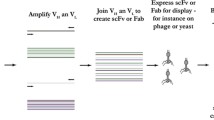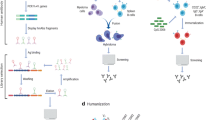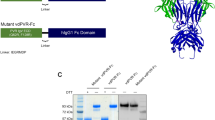Abstract
An unusually high production of cytokines or chemokines as well as increased complement activation can drive development of chronic inflammatory autoimmune diseases. State-of-the-art biological therapies, recombinant receptors, or specific antibodies that target immune and inflammatory mediators are now effectively used. However, these newer drugs are not equally effective for all patients and can cause adverse effects, making the search for new immunomodulatory proteins of great importance. The poxviruses—first and foremost, the variola (smallpox) virus, which is highly pathogenic in man—code for numerous highly evolved and extraordinarily effective immunomodulatory proteins that bind cytokines, chemokines, and proteins of the complement system. The discovery of and investigation into immune modulators from the variola virus has great potential for guiding new and effective drugs for autoimmune diseases.
Similar content being viewed by others
References
Gerard C, Rollins BJ. Chemokines and disease. Nat Immunol. 2001;2:108–15.
Markiewski MM, Lambris JD. The role of complement in inflammatory diseases from behind the scenes into the spotlight. Am J Pathol. 2007;171:715–27.
Rahman MM, Lucas AR, McFadden G. Viral TNF inhibitors as potential therapeutics. In: Fallon PG, editor. Pathogen-derived immunomodulatory molecules. New York: Springer Science + Business Media; 2009. p. 64–77.
Li K, Sacks SH, Zhou W. The relative importance of local and systemic complement production in ischaemia, transplantation and other pathologies. Mol Immunol. 2007;44:3866–74.
Bucht A, Larsson P, Weisbrot L, et al. Expression of interferon-gamma (IFN-gamma), IL-10, IL-12 and transforming growth factor-beta (TGF-beta) mRNA in synovial fluid cells from patients in the early and late phases of rheumatoid arthritis (RA). Clin Exp Immunol. 1996;103:357–67.
Hitraya EG, Schaible TF. Anti-tumor necrosis factor therapies in Crohn’s disease and rheumatoid arthritis. In: Ciliberto G, Savino R, editors. Cytokine inhibitors. New York: Marcel Dekker, Inc.; 2001. p. 97–131.
Skurkovich S, Loukina G, Sigidin Y, Skurkovich B. Successful first-time use of antibodies to interferon-gamma alone and in combined with antibodies to tumor necrosis factor-alfa to treat rheumatic disease (rheumatoid arthritis, systemic lupus erythematosus, psoriatic arthritis, Behcet`s syndrome). Int J Immunother. 1998;14:23–32.
Skurkovich S, Boiko A, Beliaeva I, et al. Randomized study of antibodies to IFN-gamma and TNF-alpha in secondary progressive multiple sclerosis. Mult Scler. 2001;7:277–84.
Alcami A, Koszinowski UH. Viral mechanisms of immune evasion. Mol Med Today. 2000;9:365–72.
Seet BT, Johnston JB, Brunetti CR, et al. Poxviruses and immune evasion. Annu Rev Immunol. 2003;21:377–423.
Shchelkunov SN. Orthopoxvirus genes that mediate disease virulence and host tropism. Adv Virol. 2012;. doi:10.1155/2012/524743.
Jha P, Kotwal GJ. Vaccinia complement control protein: multi-functional protein and potential wonder drug. J Biosci. 2003;28:265–71.
Lucas A, McFadden G. Secreted immunomodulatory viral proteins as novel biotherapeutics. J Immunol. 2004;173:4765–74.
Chen H, Zheng D, Davids J, et al. Viral serpin therapeutics from concept to clinic. Methods Enzymol. 2011;499:301–29.
Shchelkunov SN, Marennikova SS, Moyer RW. Orthopoxviruses pathogenic for humans. Berlin: Springer; 2005. p. 425.
Smith GL, Benfield CTO, de Motes CM, et al. Vaccinia virus immune evasion: mechanisms, virulence and immunogenicity. J Gen Virol. 2013;94:2367–92.
Shchelkunov SN. Functional organization of variola major and vaccinia virus genomes. Virus Genes. 1995;10:53–71.
Shchelkunov SN, Safronov PF, Totmenin AV, et al. The genomic sequence analysis of the left and fight species-specific terminal region of a cowpox virus strain reveals unique sequences and a cluster of intact ORFs for immunomodulatory and host range proteins. Virology. 1998;243:432–60.
Shchelkunov SN, Totmenin AV, Safronov PF, et al. Analysis of the monkeypox virus genome. Virology. 2002;297:172–94.
Shchelkunov SN. Interaction of orthopoxviruses with the cellular ubiquitin-ligase system. Virus Genes. 2010;41:309–18.
Gileva IP, Nepomnyashchikh TS, Antonets DV, et al. Properties of the recombinant TNF-binding proteins from variola, monkeypox, and cowpox viruses are different. Biochim Biophys Acta. 2006;1764:1710–8.
Epperson ML, Lee CA, Fremont DH. Subversion of cytokine networks by virally encoded decoy receptors. Immunol Rev. 2012;250:199–215.
Shchelkunov SN. How long ago did smallpox virus emerge? Arch Virol. 2009;154:1865–71.
Shchelkunov SN. Emergence and reemergence of smallpox: the need in development of a new generation smallpox vaccine. Vaccine. 2011;29(Suppl. 4):D49–53.
Shisler JL. Immune evasion strategies of molluscum contagiosum virus. Adv Virus Res. 2015;92:201–52.
Brandt J, Braun J. Anti-TNF-alpha agents in the treatment of psoriatic arthritis. Expert Opin Biol Ther. 2006;6:99–107.
Culy CR, Keating GM. Spotlight on etanercept in rheumatoid arthritis, psoriatic arthritis and juvenile rheumatoid arthritis. BioDrugs. 2003;17:139–45.
Agarwal SK. Biologic agents in rheumatoid arthritis: an update for managed care professionals. J Manag Care Pharm. 2011;17:S14–8.
Baji P, Pentek M, Czirjak L, et al. Efficacy and safety of infliximab-biosimilar compared to other biological drugs in rheumatoid arthritis: a mixed treatment comparison. Eur J Health Econ. 2014;15:S53–64.
Mease PJ, Wei N, Fudman EJ, et al. Safety, tolerability, and clinical outcomes after intraarticular injection of a recombinant adeno-associated vector containing a tumor necrosis factor antagonist gene: results of phase ½ study. J Rheumatol. 2010;37:692–703.
Zhou X, Gao K, Shen L, et al. Modulation of immune and inflammatory responses on experimental arthritis following intraarticular gene transfer of tumor necrosis factor receptor-immunoglobulin Fc. Rheumatol Int. 2012;32:2605–14.
Alejo A, Ruiz-Arguello MB, Ho Y, et al. A chemokine-binding domain in the tumor necrosis factor receptor from variola (smallpox) virus. Proc Natl Acad Sci USA. 2006;103:5995–6000.
Antonets DV, Nepomnyashchikh TS, Shchelkunov SN. SECRET domain of variola virus CrmB protein can be a member of poxviral type II chemokine-binding proteins family. BMC Res Notes. 2010;3:e271.
Nepomnyashchikh TS, Gileva IP, Grazhdantseva AA, et al. Comparison of properties of TNF-binding orthopoxvirus proteins and their chimeras with an IgG heavy chain fragment. Mol Med. 2008;2:48–55.
Gileva IP, Nepomnyashchikh TS, Ryazankin IA, Shchelkunov SN. Recombinant TNF-binding protein from variola virus as a novel potential TNF antagonist. Biochemistry (Moscow). 2009;74:1356–62.
Ivanisenko NV, Tregubchak TV, Saik OV, et al. Exploring interaction of TNF and orthopoxviral CrmB protein by surface plasmon resonance and free energy calculation. Prot Pept Lett. 2014;21:1273–81.
Tsyrendorzhiev DD, Sennikov SV, Orlovskaya IA, et al. Efficiency of recombinant TNF-binding protein from variola virus in a model of collagen-induced arthritis. Med Immunol. 2013;15:513–24.
Gileva IP, Viazovaia EA, Toporkova LB, et al. TNF binding protein of variola virus acts as a TNF antagonist at epicutaneous application. Curr Pharm Biotech. 2015;16:72–6.
Tregubchak TV, Shekhovtsov SV, Nepomnyashchikh TS, et al. TNF-binding domain of the variola virus CrmB protein synthesized in Escherichia coli cells effectively interacts with human TNF. Dokl Biochem Biophys. 2015;462:176–80.
Tsyrendorzhiev DD, Orlovskaya IA, Sennikov SV, et al. Biological effects of individually synthesized TNF-binding domain of variola virus CrmB protein. Bull Exp Biol. 2014;157:249–52.
Markiewski MM, Lambris JD. The role of complement in inflammatory diseases from behind the scenes into the spotlight. Am J Pathol. 2007;171:715–27.
Li K, Sacks SH, Zhou W. The relative importance of local and systemic complement production in ischaemia, transplantation and other pathologies. Mol Immunol. 2007;44:3866–74.
Uvarova EA, Shchelkunov SN. Species-specific differences in the structure of orthopoxvirus complement-binding protein. Virus Res. 2001;81:39–45.
Kotwal GJ, Moss B. Vaccinia virus encodes a secretory polypeptide structurally related to complement control proteins. Nature. 1988;335:176–8.
Liszewski MK, Atkinson JP. Novel complement inhibitors. Exp Opin Invest Drugs. 1998;7:323–31.
Smith SA, Mullin NP, Parkinson J, et al. Conserved surface-exposed K/R-X-K/R motifs and net positive charge on poxvirus complement control proteins serve as putative heparin binding sites and contribute to inhibition of molecular interactions with human endothelial cells: a novel mechanism for evasion of host defense. J Virol. 2000;74:5659–66.
Liszewski MK, Leung MK, Hauhart R, et al. Structure and regulatory profile of the monkeypox inhibitor of complement: comparison to homologs in vaccinia and variola and evidence for dimer formation. J Immunol. 2006;176:3725–34.
Miller CG, Shchelkunov SN, Kotwal GJ. The cowpox virus-encoded homolog of the vaccinia virus complement control protein is an inflammation modulatory protein. Virology. 1997;229:126–33.
Rosengard AM, Liu Y, Nie Z, Jimenez R. Variola virus immune evasion design: expression of a highly efficient inhibitor of human complement. Proc Natl Acad Sci USA. 2002;99:8808–13.
Ghebremariam YT, Odunuga OO, Janse K, Kotwal GJ. Humanized recombinant vaccinia virus complement control protein (hrVCP) with three amino acid changes, H98Y, E102K, and E120K creating an additional putative heparin binding site, is 100-fold more active than rVCP in blocking both classical and alternative complement pathways. Ann N Y Acad Sci. 2005;1056:113–22.
Pillay NS, Kellaway LA, Kotwal GJ. Administration of vaccinia virus complement control protein shows significant cognitive improvement in a mild injury model. Ann N Y Acad Sci. 2005;1056:450–61.
Pillay NS, Kellaway LA, Kotwal GJ. Vaccinia virus complement control protein significantly improves sensorimotor function recovery after severe head trauma. Brain Res. 2007;1153:158–65.
Reynolds DN, Smith SA, Zhang YP, et al. Vaccinia virus complement control protein modulates inflammation following spinal cord injury. Ann N Y Acad Sci. 2003;1010:534–9.
Reynolds DN, Smith SA, Zhang YP, et al. Vaccinia virus complement control protein reduces inflammation and improves spinal cord integrity following spinal cord injury. Ann N Y Acad Sci. 2004;1035:165–78.
Thorbjornsdottir P, Kolka R, Gunnarsson E, et al. Vaccinia virus complement control protein diminishes formation of atherosclerotic lesions: complement is centrally involved in atherosclerotic disease. Ann N Y Acad Sci. 2005;1056:1–15.
Anderson JB, Smith SA, van Wijk R, et al. Vaccinia virus complement control protein inhibits hyperacute xenorejection in a guinea pig-to-rat heterotopic cervical cardiac xenograft model by blocking both xenoantibody binding and complement pathway activation. Transpl Immunol. 2003;11:129–35.
Anderson JB, Smith SA, van Wijk R, et al. Vaccinia virus complement control protein ameliorates hyperacute xenorejection by inhibiting xenoantibody binding. Transplant Proc. 2002;34:3277–81.
Alcami A, Lira SA. Modulation of chemokine activity by viruses. Curr Opin Immunol. 2010;22:482–7.
Lalani AS, Graham K, Mossman K, et al. The purified myxoma virus gamma interferon receptor homolog M-T7 interacts with the heparin-binding domains of chemokines. J Virol. 1997;71:4356–63.
Lindow M, Luttichau HR, Schwartz TW. Viral leads for chemokine-modulatory drugs. Trends Pharmacol Sci. 2003;24:126–30.
Boomker JM, de Leij LF, The TH, Harmsen MC. Viral chemokine-modulatory proteins: tools and targets. Cytokine Growth Factor Rev. 2005;16:91–103.
Liu L, Lalani A, Dai E, et al. The viral anti-inflammatory chemokine-binding protein M-T7 reduces intimal hyperplasia after vascular injury. J Clin Invest. 2000;105:1613–21.
Bedard EL, Kim P, Jiang J, et al. Chemokine-binding viral protein M-T7 prevents chronic rejection in rat renal allografts. Transplantation. 2003;76:249–52.
Liu L, Dai E, Miller L, et al. Viral chemokine-binding proteins inhibit inflammatory responses and aortic allograft transplant vasculopathy in rat models. Transplantation. 2004;77:1652–60.
Dai E, Liu L-Y, Wang H, et al. Inhibition of chemokine-glycosaminglycan interactions in donor tissue reduces mouse allograft vasculopathy and transplant rejection. PLoS ONE. 2010;5:e10510.
Dabbagh K, Xiao Y, Smith C, et al. Local blockade of allergic airway hyperreactivity and inflammation by the poxvirus-derived pan-CC-chemokine inhibitor vCCI. J Immunol. 2000;165:3418–22.
Bursill CA, Cash JL, Channon KM, Greaves DR. Membrane-bound CC chemokine inhibitor 35K provides localized inhibition of CC chemokine activity in vitro and in vivo. J Immunol. 2006;177:5567–73.
White GE, McNeill E, Christou I, et al. Site-directed mutagenesis of the CC chemokine binding protein 35K-Fc reveals residues essential for activity and mutations that increase the potency of CC chemokine blockade. Mol Pharmacol. 2011;80:328–36.
White GE, Iqbal AJ, Greaves DR. CC chemokine receptors and chronic inflammation-therapeutic opportunities and pharmacological challenges. Pharmacol Rev. 2013;65:47–89.
Bursill CA, Choudhury RP, Ali Z, et al. Broad-spectrum CC-chemokine blockade by gene transfer inhibits macrophage recruitment and atherosclerotic plaque formation in apolipoprotein E-knockout mice. Circulation. 2004;110:2460–6.
Bursill CA, McNeill E, Wang L, et al. Lentiviral gene transfer to reduce atherosclerosis progression by long-term CC-chemokine inhibition. Gene Ther. 2009;16:93–102.
Bucht A, Larsson P, Weisbrot L, et al. Expression of interferon-gamma (IFN-gamma), IL-10, IL-12 and transforming growth factor-beta (TGF-beta) mRNA in synovial fluid cells from patients in the early and late phases of rheumatoid arthritis (RA). Clin Exp Immunol. 1996;103:357–67.
Autschbach F, Giese T, Gassler N, et al. Cytokine/chemokine messenger-RNA expression profiles in ulcerative colitis and Crohn’s disease. Virchows Arch. 2002;441:500–13.
Asadullah K, Docke WD, Volk HD, Sterry W. The pathophysiological role of cytokines in psoriasis. Drugs Today (Barc). 1999;35:913–24.
Almawi WY, Tamim H, Azar ST. T helper type 1 and 2 cytokines mediate the onset and progression of type I (insulin-dependent) diabetes. J Clin Endocrinol Metab. 1999;84:1497–502.
Sany Y. Cytokine expression during orthotopic allograft rejection in mice. Invest Ophthalmol Vis Sci. 1998;39:1953–7.
Hoffmann R. The potential role of cytokines and T cells in alopecia areata. J Invest Dermatol. 1999;4:235–48.
http://www.clinicaltrials.gov/ct/show/NCT00072943. Accessed 22 Jan 2016.
Alcami A, Smith GL. Vaccinia, cowpox, and camelpox viruses encode soluble gamma interferon receptors with novel broad species specificity. J Virol. 1995;69:4633–9.
Smith VP, Alcami A. Inhibition of interferons by ectromelia virus. J Virol. 2002;76:1124–34.
Nepomnyashchikh TS, Lebedev LR, Ryazankin IA, et al. Comparison of the interferon-gamma binding proteins of the variola and monkeypox viruses. Mol Biol (Moscow). 2005;39:926–33.
Nuara AA, Bai H, Chen N, et al. The unique C termini of orthopoxvirus gamma interferon binding proteins are essential for ligand binding. J Virol. 2006;80:10675–82.
Tardif JC, L’Allier PPL, Gregoire J, et al. A randomized controlled, phase 2 trail of the viral serpin Serp-1 in patients with acute coronary syndromes undergoing percutaneous coronary intervention. Circ Cardiovasc Interv. 2010;3:543–8.
Author information
Authors and Affiliations
Corresponding author
Ethics declarations
Conflict of interest
GAS and SNS declare that they have no conflicts of interest.
Funding
This work was supported by the Russian Science Foundation (Grant No. 14-15-00050).
Rights and permissions
About this article
Cite this article
Shchelkunova, G.A., Shchelkunov, S.N. Immunomodulating Drugs Based on Poxviral Proteins. BioDrugs 30, 9–16 (2016). https://doi.org/10.1007/s40259-016-0158-5
Published:
Issue Date:
DOI: https://doi.org/10.1007/s40259-016-0158-5




